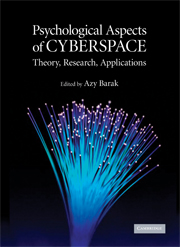Book contents
- Frontmatter
- Contents
- List of Tables
- List of Figures
- Preface
- List of Contributors
- 1 Reflections on the Psychology and Social Science of Cyberspace
- 2 Privacy, Trust, and Disclosure Online
- 3 Internet Abuse: Emerging Trends and Lingering Questions
- 4 Flow Experience in Cyberspace: Current Studies and Perspectives
- 5 Cybertherapeutic Theory and Techniques
- 6 Exposure in Cyberspace as Means of Enhancing Psychological Assessment
- 7 Down the Rabbit Hole: The Role of Place in the Initiation and Development of Online Relationships
- 8 The Sexy Side of the Internet: An Examination of Sexual Activities and Materials in Cyberspace
- 9 The Contact Hypothesis Reconsidered: Interacting via Internet: Theoretical and Practical Aspects
- 10 Influences on the Nature and Functioning of Online Groups
- 11 Online Motivational Factors: Incentives for Participation and Contribution in Wikipedia
- 12 How Internet-Mediated Research Changes Science
- Index
- References
3 - Internet Abuse: Emerging Trends and Lingering Questions
Published online by Cambridge University Press: 05 June 2012
- Frontmatter
- Contents
- List of Tables
- List of Figures
- Preface
- List of Contributors
- 1 Reflections on the Psychology and Social Science of Cyberspace
- 2 Privacy, Trust, and Disclosure Online
- 3 Internet Abuse: Emerging Trends and Lingering Questions
- 4 Flow Experience in Cyberspace: Current Studies and Perspectives
- 5 Cybertherapeutic Theory and Techniques
- 6 Exposure in Cyberspace as Means of Enhancing Psychological Assessment
- 7 Down the Rabbit Hole: The Role of Place in the Initiation and Development of Online Relationships
- 8 The Sexy Side of the Internet: An Examination of Sexual Activities and Materials in Cyberspace
- 9 The Contact Hypothesis Reconsidered: Interacting via Internet: Theoretical and Practical Aspects
- 10 Influences on the Nature and Functioning of Online Groups
- 11 Online Motivational Factors: Incentives for Participation and Contribution in Wikipedia
- 12 How Internet-Mediated Research Changes Science
- Index
- References
Summary
There has been much alarm about Internet abuse in the past decade. Claims of Internet-related crimes such as homicides, suicides, and child neglect have received widespread media attention across the globe (“Chinese Gamer Sentenced to Life,” 2005; Spain & Vega, 2005). Many claim that they are or know someone who is addicted to the Internet. Fifteen percent of university students in the United States and Europe and 26 percent of Australian students claim they know someone is addicted to the Internet (Anderson, 1999; Wang, 2001). Almost 10 percent of adult Internet users in a large online study self-identified as Internet addicts (Cooper, Morahan-Martin, Mathy, & Maheu, 2002), while 31 percent of MySpace users (Vanden Boogart, 2006) and 42 percent of online gamers (Yee, 2002) say they are addicted to those Internet applications. In Germany, a camp was established to help children who were addicted to the Internet (Moore, 2003). It is tempting to dismiss these claims as media hype, but clinicians also have reported Internet-related problems and have set up clinics specifically to treat these problems in many countries. In recent years, governments in Asia have established clinics and intervened to reduce Internet use. The first Chinese clinic for Internet addiction in Beijing has expanded from 40 to 300 inpatient beds, and new clinics are being established in other Chinese cities (Griffiths, 2005; Lin-Liu, 2006).
- Type
- Chapter
- Information
- Psychological Aspects of CyberspaceTheory, Research, Applications, pp. 32 - 69Publisher: Cambridge University PressPrint publication year: 2008
References
- 37
- Cited by



